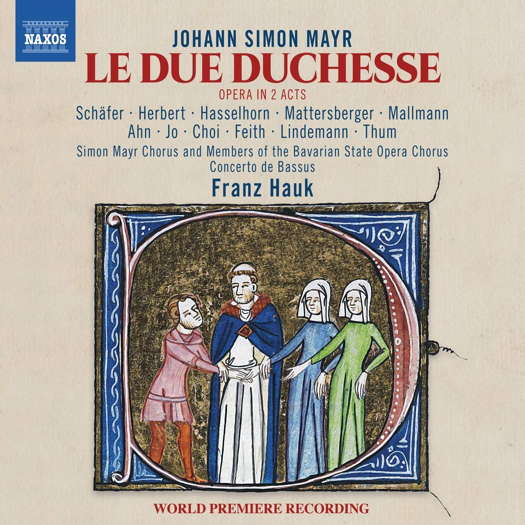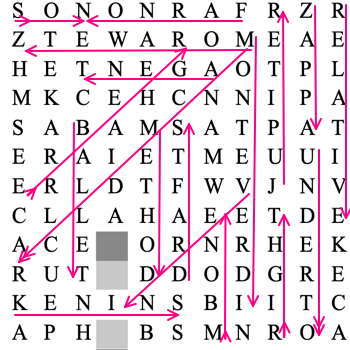 FEEDBACK: She said WHAT? Read what people think about our Classical Music Daily features, and have your say!
FEEDBACK: She said WHAT? Read what people think about our Classical Music Daily features, and have your say!

Between Centuries and Cultures
GIUSEPPE PENNISI listens to Johann Simon Mayr's 1814 opera 'Le due duchesse'
'The richness is clear from the Sinfonia.'
Johann Simon Mayr (1763-1845) lived and composed between two centuries (the eighteenth and the nineteenth) and two musical cultures (the German-Austrian and the Italian) and influenced composers in most of Europe. In his later years, he himself was influenced mainly by the young Rossini's opera seria. Thus, even though Mayr's works, among which there are almost seventy operas, are rarely performed today, it is worth studying his compositions and listening to his music.
This CD is particularly important because it is the premiere recording of Le due duchesse which had its debut in Milan at La Scala in 1814 and was revived in Naples in 1819 and again in Florence in 1824. Most likely, there were differences among the three versions; for instance, for the performances in Naples, the buffo parts were re-written in Neapolitan dialect. For this recording, a careful critical edition was developed based on the manuscript in the library in Bergamo.
A few words on the composer's life: Mayr was born at Mendorf in Bavaria and studied theology at the University of Ingolstadt, continuing his studies in Italy from 1787. He was closely associated with the Illuminati of Adam Weishaupt while a student in Ingolstadt; the ideals of the French Enlightenment were a strong influence on his philosophy as a musician as corroborated by his famed Zibaldone or 'Notebooks' compiled toward the end of his career.
Shortly thereafter, he took music lessons with Carlo Lenzi, and later with Ferdinando Bertoni. He moved to Bergamo in 1802 and was appointed maestro di cappella of the Cathedral of Bergamo, succeeding his old teacher Lenzi. He held the post until his death and became a central figure in the city's musical life, organizing concerts and introducing Ludwig van Beethoven's music there. He was music teacher to Gaetano Donizetti. By the end of his life, he was blind. He died in Bergamo and is buried in the Basilica di Santa Maria Maggiore there, just in front of the tomb of his famous pupil.
Le due duchesse belongs to Mayr's mature period when he could no longer be considered a 'classical' composer but he was clearly a 'pre-romantic' composer under the influence of young Rossini's early masterpieces. Felice Romani's libretto is broadly based on a poem, Elfrida, by the British pre-romantic poet William Mason; in his turn, William Mason attempted to adapt ancient Greek tragedies to the new Gothic style. In fact, the poem had already been the subject of the tragic opera Elfrida by Giovanni Paisiello which, with a libretto by Ranieri da Calzabigi, had its debut in Naples in 1792. It was not easy for Romani to transform the gloomy plot into a semi-serious opera, the genre then much acclaimed by the audience. However, he was a serious and skilled professional and did a very good job.
The two act opera lasts a little more than two hours. The plot is extremely complicated. In my opinion, it does not need to be summarized in this review. The interesting aspects of the CD are how a young orchestral ensemble, Concerto de Bassus, conducted by Frank Hauk, a young international cast and a good chorus - the Simon Mayr chorus strengthened by members of the Bavarian Opera Chorus - render this unknown score.
The richness is clear from the Sinfonia.
Listen — Johann Simon Mayr: Sinfonia (Le due duchesse)
(CD1 track 1, 1:42-2:31) © 2020 Naxos Rights (Europe) Ltd :
This is followed by an introduction during which almost all the principals are on stage.
Listen — Johann Simon Mayr: Ecco il castello castel vietato (Le due duchesse Act I)
(CD1 track 2, 8:52-9:52) © 2020 Naxos Rights (Europe) Ltd :
The main soprano - Eun-Hye Choi as Malvina - has a lush entry aria.
Listen — Johann Simon Mayr: Giorni i momenti sono (Le due duchesse Act I)
(CD1 track 6, 1:39-2:38) © 2020 Naxos Rights (Europe) Ltd :
A series of small numbers - duets, recitatives and simple arias - prepare the grandiose entry of the first tenor, Young-Jun Ahn as Edgar, in an aria with chorus and with the presence of the second tenor, Markus Schäfer as Enrico.
Again in the Act I grand finale - about twenty minutes - nearly all the singers and the chorus are on stage and the listener feels a Rossini-like atmosphere.
Listen — Johann Simon Mayr: Perdonate (Le due duchesse Act I Finale)
(CD2 track 1, 14:18-15:16) © 2020 Naxos Rights (Europe) Ltd :
Act II is shorter and not as interesting as Act I. There is a highly dramatic duet between soprano Eun-Hye Choi as Malvina and bass Jeagyeong Jo as Loredano.
Listen — Johann Simon Mayr: Morte! ... (Le due duchesse Act II)
(CD2 track 5, 4:36-5:27) © 2020 Naxos Rights (Europe) Ltd :
There's also a crafty sextet when two other singers and characters, soprano Tina Marie Herbert as Laura and baritone Samuel Hasselhorn as Berto, join the already mentioned four principals.
Listen — Johann Simon Mayr: Deh! Prendetevi una volta (Le due duchesse Act II)
(CD2 track 10, 12:54-13:46) © 2020 Naxos Rights (Europe) Ltd :
And there's a fifteen minute grand finale when the full company rejoices at the happy ending.
Listen — Johann Simon Mayr: Della provincia intera (Le due duchesse Act II)
(CD2 track 17, 13:46-14:46) © 2020 Naxos Rights (Europe) Ltd :
A final remark: the reader will have noticed that excellent young Koreans sing three of the four major roles. I spent several weeks in South Korea in the early 1970s and was amazed by the operatic culture of the country. To listen to them is an additional reason to appreciate this recording.
Copyright © 23 September 2020
Giuseppe Pennisi,
Rome, Italy

CD INFORMATION - MAYR: LE DUE DUCHESSE
FURTHER INFORMATION: JOHANN SIMON MAYR
FURTHER EIGHTEENTH CENTURY MUSIC ARTICLES
FURTHER NINETEENTH CENTURY MUSIC ARTICLES



